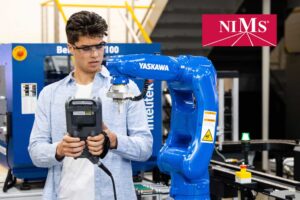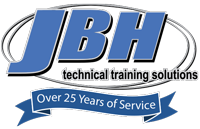Today’s manufacturing environments are heavily automated. Robotics is the foundation of industrial automation, and the need for robotics technicians, programmers, designers and installers is growing faster than the supply of qualified employees.
Consider these statistics from the Advanced Robotics for Manufacturing (ARM) Institute, a membership-based organization focused on robotics and workforce development:
- As of Dec. 2021, there were 768,000 open manufacturing jobs in the United States. Of these, 15,000 were robotics-related jobs.
- Over the next decade, 4.6 million jobs will need to be filled in the U.S. manufacturing sector—and 2.4 million of these jobs might go unfilled because of a lack of trained workers.
- On average, robotics-related manufacturing jobs pay about 30 percent more than entry-level, non-robotics manufacturing jobs. Beginning robotics technicians who keep machinery running smoothly can earn $61,000 per year, on average—while advanced robotics integrators who understand how robotics can improve manufacturing operations can earn $130,000 per year.
High school and college career and technical education (CTE) programs can help meet the demand for skilled robotics workers. Training students how to service, program and design robotic equipment used in manufacturing and other fields can prepare them for stable, high-paying jobs—while also filling a key industry need.
Common positions requiring robotics-related skills include:
- Robotics technicians, who focus on the day-to-day maintenance of automated machinery on the manufacturing floor. This entry-level position is perfect for starting a career in robotics. Robotics technicians know how robots work, how to operate the robot and maintain the robot. They can make adjustments to the robot operation and how the robot operates with other equipment in the factory.
- Robotics specialists, who are more knowledgeable about robotic systems on the manufacturing floor. These specialists are responsible for implementing upgrades to automated manufacturing systems that can increase productivity. This position requires more training than the technician role. Robotic specialist will be able to program the robot to enhance or change the tasks the robot performs and to add new robots to manufacturing or industrial processes.
- Robotics integrators, who are the subject matter experts on automation and robotics. They understand how applying robots and automation to the manufacturing process benefits operations and evaluate, design, and implement plans for using robotics to enhance automation. Of these three positions, the Robotics Integrator requires the highest level of training and experience.
While robotics jobs require more specialized training than other manufacturing jobs, a high school diploma or GED is acceptable to many manufacturers for entry-level robotics positions. CTE program leaders can learn more about these positions (as well as other robotics career paths) at RoboticsCareer.org, a website from the ARM Institute.
Since 1982, Intelitek has been a pioneer in training systems for industrial robotics. Intelitek offers a number of solutions to help high school and college CTE programs integrate robotics training for students, including robotics carts that combine hardware and curriculum within a simple, all-in-one solution.
For instance, the Motoman GP8 fenceless cart for education is a solution that’s perfect for small spaces. It includes the GP8, a six-axis robotic arm with a 17-pound payload and 28-inch reach that students can use to program and learn a variety of robotic functions. The Intelitek Fundamentals or Advanced curriculum for Robotics pair with micro-credentials for a Robotic Operator and Robotic Programmer. The full cart solution includes software, educational resources, and training from Yaskawa.
Intelitek’s New SmartCart 4.0 integrates robotics with other systems in an industrial setting and teaches Industry 4.0 specific competencies. The SmartCart 4.0 aligns with Industry 4.0 Smart Credentials from NIMS.
To learn about Intelitek’s entire catalog of robotics-related products for education, click here.























